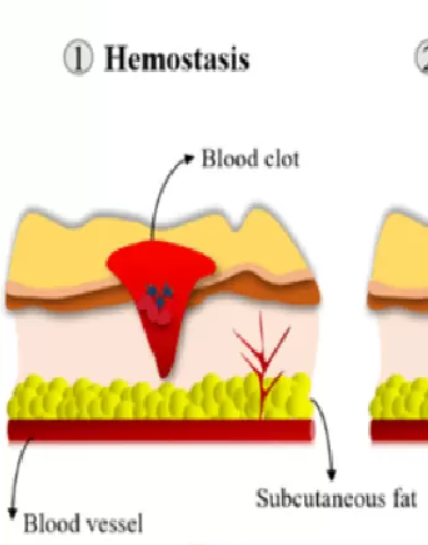phases of Wound Healing –Wound healing is a complex and dynamic process that occurs in several distinct phases. Understanding these phases is crucial for effective wound management and promoting optimal healing. In this article phases of Wound Healing, we will explore the different phases of wound healing, their characteristics, and factors that can influence the healing process. Phases of Wound Healing -Hemostasis stage, Inflammatory process, Proliferative Phase The stages of wound healing proceed in an organized way and follow four Stages:
The Four Phases of Wound Healing
When the skin is injured, the body goes through a series of complex steps to repair the damage. This process is called wound healing, and it can be divided into four phases: hemostasis, inflammation, proliferation, and remodeling.
1. Hemostasis
During the hemostasis stage, the body works to stop bleeding from the wound. Platelets gather at the site of injury and form a clot to prevent further blood loss. This clot acts as a temporary seal for the wound until the more robust scar tissue forms later in the healing process. Proper hemostasis is essential to avoid excessive bleeding and promote the next stages of healing.

2. Inflammation
The second stage of wound healing is inflammation. This stage begins immediately after injury and lasts for several days. When a wound occurs, the body’s immune system responds by sending white blood cells to the affected area. These cells fight off infection and remove any foreign substances present in the wound. As a result, the area becomes red, swollen, and tender to the touch. While inflammation is a natural part of the healing process, excessive inflammation can delay healing.

3. Proliferation
The proliferation stage is the phase during which the body rebuilds the damaged tissue. New blood vessels develop, and granulation tissue forms. This tissue contains collagen, which is a crucial protein in wound healing. It provides a framework for new skin cells to grow, leading to the closure of the wound. This stage typically occurs a few days after the injury and can last up to several weeks, depending on the wound’s size and depth.

4. Remodeling
The final stage of wound healing is remodeling, where the body refines and reorganizes the newly formed tissue. Collagen fibers realign to increase the wound’s tensile strength and improve the overall appearance of the healed wound. This stage can last for several months, and the wound gradually gains strength over time.

Factors Affecting Wound Healing
Several factors can influence the wound-healing process. Understanding these factors can help individuals take appropriate measures to ensure optimal healing.
There are a number of factors that can affect wound healing, including:
- The size and depth of the wound
- The location of the wound
- The age and health of the person
- The presence of infection
- The use of tobacco products
- Certain medications
Complications in Wound Healing
While most wounds heal without complications, some situations can hinder the healing process.
Infection
Infections can occur if wounds are not properly cleaned and cared for. Signs of infection include increased pain, redness, swelling, warmth, or pus at the wound site. If any of these signs are present, seek medical attention promptly.
Delayed Healing
Certain factors, such as poor blood circulation, malnutrition, and immunosuppression, can lead to delayed wound healing. It is essential to address these factors to promote timely healing.
Excessive Scarring
In some cases, excessive scar tissue can form during the healing process. This may cause cosmetic concerns or limit mobility if the scar contracts and tightens the skin excessively.
FAQ
What is wound healing?
Wound healing is the process by which the body repairs damaged tissue. It is a complex process that involves a number of different cells and proteins. The goal of wound healing is to restore the skin to its original condition.
How long does it take for a wound to heal?
The time it takes for a wound to heal depends on the size and depth of the wound, the location of the wound, and the overall health of the person. Minor cuts and scrapes may heal in a few days, while larger wounds or wounds that are infected may take weeks or even months to heal.
Is it normal for wounds to itch during the healing process?
Yes, it is common for wounds to itch as they heal. Itching is a natural part of the inflammatory response. However, avoid scratching the wound to prevent infection and delays in healing.
